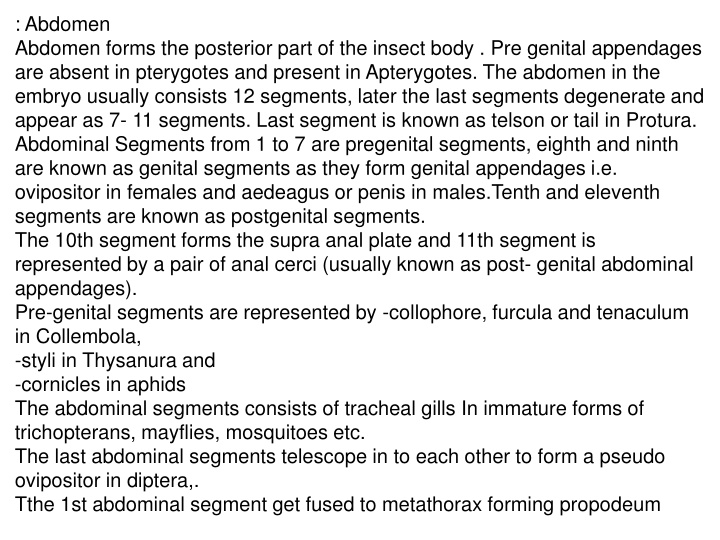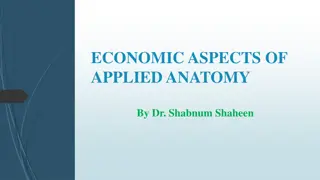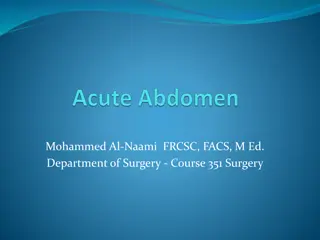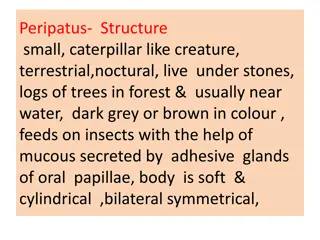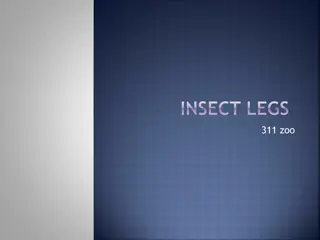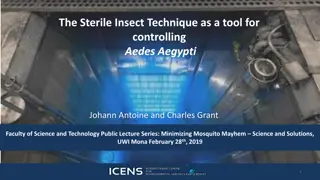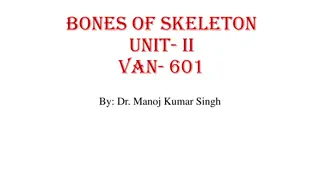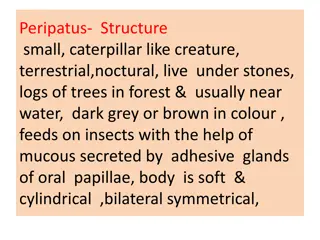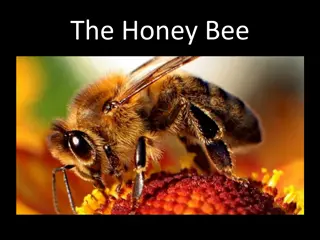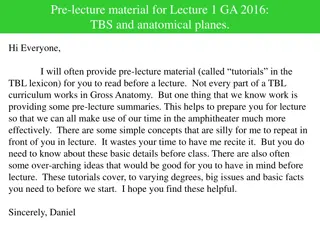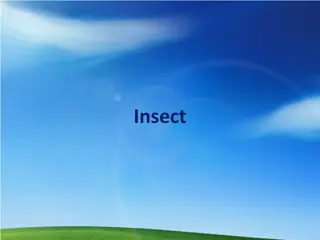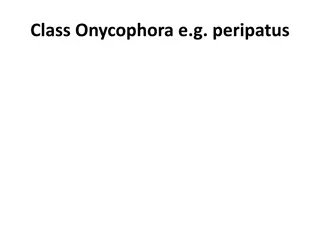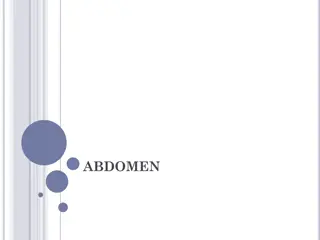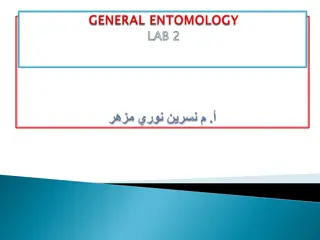Insect Body Anatomy: Abdomen and Antennae Features
The abdomen in insects is a crucial body part with distinct segments and appendages, while antennae serve as sensory structures. Explore the characteristics, types, and functions of these critical insect body elements.
Download Presentation

Please find below an Image/Link to download the presentation.
The content on the website is provided AS IS for your information and personal use only. It may not be sold, licensed, or shared on other websites without obtaining consent from the author.If you encounter any issues during the download, it is possible that the publisher has removed the file from their server.
You are allowed to download the files provided on this website for personal or commercial use, subject to the condition that they are used lawfully. All files are the property of their respective owners.
The content on the website is provided AS IS for your information and personal use only. It may not be sold, licensed, or shared on other websites without obtaining consent from the author.
E N D
Presentation Transcript
: Abdomen Abdomen forms the posterior part of the insect body . Pre genital appendages are absent in pterygotes and present in Apterygotes. The abdomen in the embryo usually consists 12 segments, later the last segments degenerate and appear as 7- 11 segments. Last segment is known as telson or tail in Protura. Abdominal Segments from 1 to 7 are pregenital segments, eighth and ninth are known as genital segments as they form genital appendages i.e. ovipositor in females and aedeagus or penis in males.Tenth and eleventh segments are known as postgenital segments. The 10th segment forms the supra anal plate and 11th segment is represented by a pair of anal cerci (usually known as post- genital abdominal appendages). Pre-genital segments are represented by -collophore, furcula and tenaculum in Collembola, -styli in Thysanura and -cornicles in aphids The abdominal segments consists of tracheal gills In immature forms of trichopterans, mayflies, mosquitoes etc. The last abdominal segments telescope in to each other to form a pseudo ovipositor in diptera,. Tthe 1st abdominal segment get fused to metathorax forming propodeum
Antennae Antennae are a pair of sensory appendages arising from the 2nd or antennal segment of the head possessing nerves. They are well developed in adults and poorly developed in immature stages.These are said to be unbranched, segmented and mobile structures which are basally fixed in to deep antennal socket . Antennal socket is provided with an antennal suture. The base of socket is connected to the edge of the socket by an articulatory membrane. This permits free movement of antennae.. Structure of antenna. Antenna consists of 3 parts Scape : It is the first segment of antenna. It articulates with the head capsule through socket which provides movement for the scape. Pedicel : It is the 2nd or middle segment of antenna that forms a joint between scape and flagellum. It consists of the special auditory organ known as Jhonston s organ . Flagellum : It is the last antennal segment which consists of many segments that varies in shape and size. Jhonston s organ is absent in Collembola & Diplura.
Types of Antennae: Filiform (Thread like) ex :Grasshopper Segments are more or less uniform throughout from base to apex and never ends with bristle. 2.Setaceous(Whip/ bristle like) ex : Cockroach Segments gradually decrease in size from base to apex presenting a whip or bristle like structure. 3.Moniliform (Like string of beads) ex :Termites Segments are round or oval with well developed constrictions between segments, appearing like a string of beads. 4.Pectinate (Comb like) ex : Female arctid moth Segments possess lateral processes on one side giving comb like appearance. 5.Bipectinate (Double comb) ex : Male Lymantrid moth,mulberry silk moth Segments bear lateral processes on either side ,givng double comb like appearance. 6.Serrate(Saw like) ex : Pulse beetle, jewel beetles Segments of flagellum are triangular with projecting points on one side giving saw like appearance.
7.Clavate (Clubbed) ex :Butterflies Segments gradually increase in diameter from base to tip ending in a club like apical part. 8.Clavate with hook(clubbed antennae with hook) ex : Skipper butterflies Segments gradually increase in diameter from base to tip and the last one ends with a small hook like structure. 9.Capitate (Clubbed with knob) ex: Red flour beetle Segments gradually increase in diameter from base to apex and the terminal 3-5 segments suddenly enlarge to form a knob like structure. 10.Geniculate (Elbowed) ex : Ants, honey bees The first segment (scape) is greatly elongated and flagellum always makes an angle with it 11.Lamellate (plate like) ex : Rhinoceros beetles, dung rollers, chaffer beetles The terminal segments expand to one side and form broad plate or leaf like structure 12.Flabellate (feather like) ex : stylopids Projections of some upper segments become long and form a feather like structure called flabella
13.Plumose(brush like with dense hairs) ex : Male mosquito Whorls of hairs arise from each joint of the segment. 14.Pilose (brush like with sparse hairs) ex :Female mosquito Looks like a plumose but each whorl contains less number of hairs 15.Aristate (antennae with arista) ex : House fly Antennae are small, microscopic 3 segmented. 3rd segment enlarged and bears a bristle called arista on its dorsal side 16.Stylate (antennae with style) ex : Robber fly Antennae small 3-4 segmented. Terminal segment elongate into a bristle like structure called style Functions of antenna: 1. Mainly serve as the sense organ responding to touch, smell, odour, humidity, temperature as well as air currents or wind speed. 2. Jhonston s organ on pedicel functions as an auditory organ responding to sound 3. Help the mandibles for holding prey and for mastication of food material 4. Helps in sexual dimorphism and Useful for clasping the female during copulation 6. Aid in respiration by forming an air funnel in aquatic insects.
Mouth parts of insects These are the organs primarily concerned with the uptake of food. Typical mouthpart of an insect consists of the following parts. (i) Labrum (upper lip) (ii) A pair of mandibles (iii) A pair of maxillae (iv) Labium (lower lip) (v) Hypopharynx (tongue) The mouth parts of insects can be basically grouped in to following types based on the type of food and method of feeding. I.Biting and chewing type ex :Grasshoppers, cockroaches II.Sucking type / Haustellate type 1.Piercing and sucking type ex : Plant Bugs and Mosquitoes 2.Rasping and sucking type ex : Thrips 3.Sponging type ex : Adult Houseflies 4.Chewing and lapping type ex: Honey bees 5.Siphoning type ex : Butterflies and moths III Other types 1. Mask type ex : Naids of Dragonflies 2. Degenerate type ex : Maggots of Diptera
Insect legs All the three thoracic segments of an insect possess a pair of legs as locomotory organs giving the name hexapods and the class insecta as hexapoda. Insect leg mainly consists of 5 parts viz.Coxa , Trochanter, Femur , Tibia and. Tarsus. Structure of leg 1. Coxa: It is the functional basal segment and it is rigidly fixed to thorax or weakly articulated. 2. Trochanter : It is very small and the second segment. It is articulated with coxa and more or less fixed to femur. 3. Femur : It is the largest, strongest segment and is articulated with the tibia.. 4.Tibia : It is equal or more than the length of the femur, articulated with tarsus. 5. Tarsus : it is the largest segment of the leg and usually devided into sub segments tarsomeres. The number of tarsomeres vary from 1-5 and are movable one on the other The tarsus at it s end consists of pretarsus which is in the form of a pair of claws and cushion like pulvilli. In between the claws, if there is lobe like structure, it is known as aroleum as in Orthoptera (grass hopper) and if it is bristle like structure, it is called embodium as in Diptera.
Cursorial- ex:Blister beetle, wasp Walking, All the legs uniformly well developed without any special modification Ambulatory-ex:Cockroach Running ,All legs are normal. coxa widely separated Saltatorial- ex:Grasshopper , gryllids Leaping and jumping,Femur and tibia elongated Fossorial -ex:Mole crickets, dung rollers Digging,Tibia and tarsus short and broad with teeth like projections Raptorial- ex:Preying mantids Preying (grasping ) ,femur spinose and possess a central longitudinal groove. Tibia narrow, blade like spinose and fits into the groove of femur Natatorial -ex: Water beetle, water bugs Swimming, Hind legs pad like. Tibia and tarsus short and broad having dense long marginal hairs. Scansorial- ex:Head louse clinging, Tibia possess tibial thumb. Tarsus single segmented and pretarsus with a single long curved claw
Prehensile- All legs together ex:Dragon flies Catching prey, basket forming type Thoracic segments obliquely arranged . Thoracic plates and legs together from a basket like structure useful for catching the prey even in flight Antennal cleaning legs- Front legs ,ex:Honey bee For cleaning antennae,Tibia possess a movable spine, and the first tarsal segment with a semicircular notch Wax pick type -Middle legs ex:Honey bee For picking wax plates,Tibia possess a spine called wax pick for removing the wax plates from the ventral side of the abdomen Pollen basket and brush type -Hind legs,ex:Honey bee For collecting pollen ,Inner surface of large tibia has a groove and is used as pollen basket or Corbicula cleaning the body for temporary storage of pollen grains. First tarsal segment enlarged and possess short stiff hairs Pecten all over the surface called pollen brush.
COMPOUND EYES Compound eyes individual facets or lenses called ommatidia which can visualize colours. Coumpound eyes are absent in majority of larvae of insects that undergo complete metamorphosis and also in primitive wingless insects. SIMPLE EYES The dorsal ocelli, or simple eyes, are commonly three in number. Two different forms of ocelli have been described for insects, Dorsal ocelli and Lateral ocelli. Dorsal ocelli occur mostly in adult insects and are situated on the front of the insects face in the area of the 'frons' and or the 'epicranium'. Lateral ocelli generally occur on the sides of the insect head and are the form of eye most common in larval forms. Cockroach-Fenestrae-Reduced ocelli Tentorium: At each of four points on the cranium the cuticle forms an arm like inflection. Internally these inflections join, forming a framework. This internal framework, the tentorium affords many points for muscle attachment. It contributes to the rigidity of the head capsule, and provides support for the brain and the part of the foregut that passes through the head.
Different types of wings 1. Tegmina : Forewings are leathery and tough . They protect the membranous hindwings.e.g.: forewings wings of cockroach, grasshopper 2. Elytra : Hard, shell like without clear venation. They form horny sheet and protect the membranous hind wings and abdomen. e.g. Forewings beetles 3. Hemelytra : The base of the wing is thick like elytra and the remaining half is membranous. They are useful of protection and flight e.g.Forewings bugs 4. Membranous : Naked thin with clear venation. Always useful of flight e.g.: Both the wings of Dragonflies, bees and wasps,Hind wings of grasshopper, beetles etc. 5. Scaly wings : Wings thin, membranous but covered with unicellular scales all over the surface .They are useful for flight e.g.: Both the wings of moths and butterflies. 6. Fringed wings : Wings are highly reduced with reduced venation. The wings are fringed with long marginal hairs giving a feather like appearance e.g.:Both wings of thrips
7. Fissured wings : Forewings are longitudinally divided twice forming a fork like structure whereas hindwings are divided twice in to three arms. All the forks possess small marginal hairs . They are useful for flight.e.g.:plume moth 8. Halteres : The hind wings of houseflies are modified in to small microscopic structures called halteres and are divided in to three regions namely scabellum ,pedicel and capitellum.They act as balancers. eg. Hind wings housefly and front wings of male stylopids 9. Pseudohalteres : They are short and modified in to pseudohalteres which are dumbbell shaped. Eg: Front wings of Strepsiptera
